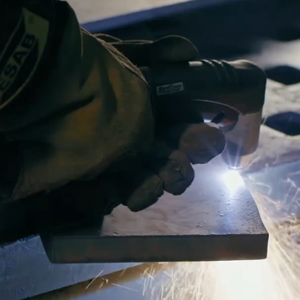The truth is that there’s still millions of welders across the world that don’t even have a basic understanding of plasma cutting and how it works. Even within the last 10 years, plasma cutting has entirely changed. So, why do I need to know about plasma cutting at all? When it comes to ways of manipulating metal, plasma cutting opens up a whole new world of possibilities. And while plasma cutting won’t be replacing all other cutting methods any time soon, the undeniable truth is that it’s here to stay. Even a basic understanding will help you stay up-to-date on what’s new in the world of welding.
Space Guns!
4 decades ago, portable plasma blasters were nothing but science fiction. The original star wars trilogy actually made reference to plasma weapons being the best thing to use on mechanical droids. And while we still don’t have speeder bikes or light sabers, at least this part of a galaxy far, far away is now something we use every day.
What is plasma? We all learned about the 3 states of matter in school: gas, liquid and solid. But often plasma misses the roster. This is because even though plasma is the 4th state of matter, it doesn’t occur on earth naturally. Scientists are still trying to figure out what plasma actually is. Often plasma is simply described as a gaseous mixture of negatively charged electrons and highly charged positive ions. That’s a lot of science to basically say plasma is a gas that’s heated or subjected to a strong magnetic field.
How does Plasma Cutting Work?
Plasma cutting works by forming an electrical arc within the gas that’s blown through a plasma torches’ nozzle. The electrical arc ionizes some of the gas, creating an electrically conductive channel of plasma. This superheated gas is hot enough to easily melt through metal. At the same time, the compressed gas and high velocity plasma blow the now-liquefied metal away, successfully cutting completely through the workpiece.
This process allows your cuts to be incredibly precise. Beyond that, plasma cutting can also be performed on materials other cutting methods can’t use. In fact, plasma cutting can be utilized on any type of material that conducts electricity. Even 5 years ago, the biggest challenge for plasma was thickness. Finding a machine that could go through an inch or more could have cost a small fortune. Today, most consumer plasma machines can cut through 1.5” thick steel plate without a problem. Higher-end equipment can cut material as thick as 6”.
Things to Pay Attention To
There’s a couple “D’oh” moments most first-time plasma buyers can easily avoid if they know what to look for. One of the biggest beginner mistakes is getting the wrong air compressor for your machine. What often happens is that welders will buy just any air compressor or assume the one they have sitting around will work just fine. Plasma machines have specific air flow needs. It’s important to pay attention to both the psi and cfm requirements for your machine. If you’re air compressor can’t keep up with the airflow required for your plasma machine, your plasma machine can become damaged.
Some experts will actually tell you to have an air compressor that has at least 1.5 the required amount of cfm you’re plasma machine needs. The reason for this is that some off-brand (and even some brand-name) companies tend to exaggerate the output of their air compressors. Ultimately how much you trust (or distrust) your air compressors’ stats are up to you. Just make sure you have enough air flow to keep your plasma machine supplied.
If you’re interested in a plasma machine, but don’t want to deal with an air compressor, there are plasma cutters with built-in compressors. For instance, Hypertherm’s Powermax30 AIR has its own internal compressor. Some of these machines also have the ability to hook up to an external compressed air machine for more power, although be aware that some do not meaning you’re stuck with the internal air compressor.
Not many people realize that when Bob Dylan said “The Times, They Are A-Changin” he was talking about plasma machines. And if he wasn’t then he should have been. Because whether you’re a fan of plasma or not, understanding at least the basics is quickly becoming a vital part of keeping up with the welding world. Now that you’ve learned a little more about plasma machines, why not see how they stack up against Oxy Acetylene by clicking the button below.








